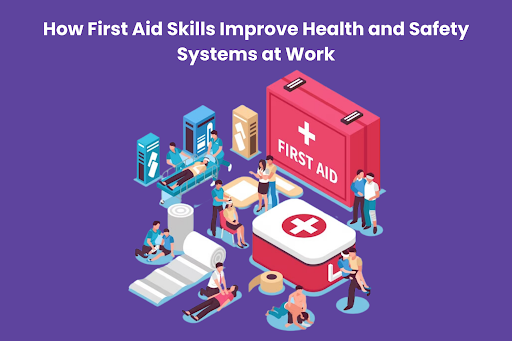It is impossible to exaggerate the value of a First Aid Course as a supplement to an extensive Health and Safety Management System in Workplace, especially given the unpredictable nature of the workplace. With this system in place and a staff of first aid experts on hand, businesses can rest easy knowing their workers are cared for.
In this blog, we will discuss the many ways in which first aid improves workplace safety, including its role in fostering a culture of safety, facilitating rapid responses to crises, aiding legal compliance, creating a more secure setting for workers, and more. Whether you’re a business owner who wants to make your workplace safer or an employee who wants to make sure you’re taking care of yourself, this blog will show you why first aid training is so important.
Table of Contents
- The Importance of First Aid at Work
- Promoting a Culture of Safety
- Immediate Response to Emergencies
- Compliance with Regulations
- Building a Safer Work Environment
- Increased Preparedness
- Reduced Response Time
- The Benefits for Employees and Employers
- Employee Well-being
- Reduced Absenteeism
- Legal and Financial Benefits for Employers
- Conclusion
The Importance of First Aid at Work
As an integral part of any effective Health and Safety Management System, first aid has a far broader scope in the workplace than just treating injuries. In this section, we’ll discuss how first aid education helps foster a culture of safety, equips workers to act swiftly in the face of crises, and guarantees conformity with rules, all of which contribute significantly to a less risky and better-prepared workplace.
Promoting a Culture of Safety
The basis of an effective Health and Safety Management System is a company culture that places a premium on safety. Employees can help develop this culture by receiving thorough first-aid training. It shows employees that management cares about their health and safety. Employees have a higher sense of safety and worth when they believe their coworkers are prepared to deal with unexpected situations.
Immediate Response to Emergencies
Workplace accidents and medical problems are always a possibility. The capacity to quickly respond to any emergency, no matter how severe, is essential. When an accident occurs, a group of first aiders who have received proper training can act quickly and provide necessary treatment until medical personnel arrive. In many circumstances, the life or health of the victim can be saved by the swift action taken in reaction to an emergency.
Compliance with Regulations
Workplace health and safety management systems are often subject to regulatory requirements and laws. Depending on the size and kind of business, a number of nations mandate that businesses have a staff of certified first aid workers at all times. Penalties and other legal repercussions can result from violating these rules. Thus, investing in first aid training serves to protect the health and safety of workers and maintain legal compliance.
Building a Safer Work Environment
Preventing accidents is just half the battle; being ready to react appropriately when they do occur is essential for a safer workplace. In this section, we’ll discuss how first aid training may make the workplace safer and more responsive for everyone by increasing readiness and decreasing response time.
Increased Preparedness
Having trained first aid personnel in the workplace reduces the risk of injury. When workers have a thorough grasp of how to react in different emergency scenarios, the preparedness of the entire workplace improves. First responders are capable of managing a wide range of medical emergencies with competence and poise.
Reduced Response Time
One of the most important elements of first aid is its ability to shorten reaction times during crises. Being close to someone who can provide aid quickly is crucial in life-threatening situations like cardiac arrest or severe bleeding. It can help the affected individual recover more quickly and increase their chances of a favourable result.
The Benefits for Employees and Employers
First aid training is an investment that provides several benefits for businesses and their personnel. This section will discuss how investing in first aid benefits everyone involved, including how it helps keep workers healthy, cuts down on absenteeism, and saves businesses money in the long run.
Employee Well-being
Corporations that provide first aid training to their staff show they care about their workers. Workers are more likely to feel appreciated and protected if they know their employers have taken precautions to protect them. In turn, this can improve workers’ happiness and morale in the workplace.
Reduced Absenteeism
In the event of a workplace accident, it is common for workers to call out sick. Sometimes, workers require more time off than usual to recuperate from illness or injury. There will be less of an effect on production if there are qualified first aiders on site to treat injuries as quickly as possible when they occur.
Legal and Financial Benefits for Employers
In addition to the ethical need of providing a risk-free workplace, first aid training also provides legal and financial protections for businesses. As mentioned before, avoiding legal trouble and hefty penalties is a major incentive to follow the law. Plus, it might help you save money on insurance since many providers provide discounts to businesses that have strong safety measures.
Conclusion
To summarise, a well-implemented Health and Safety Management System in the workplace is critical for protecting workers and ensuring a safe working environment. However, it is of equal importance to provide staff with the information and abilities necessary to react appropriately in times of crisis. Investing in a First Aid Course is important since it builds a culture of safety, boosts workers’ and employers’ preparedness, and decreases response times. Last but not least, a workplace that values first aid training is safer, more productive, and legally compliant.








